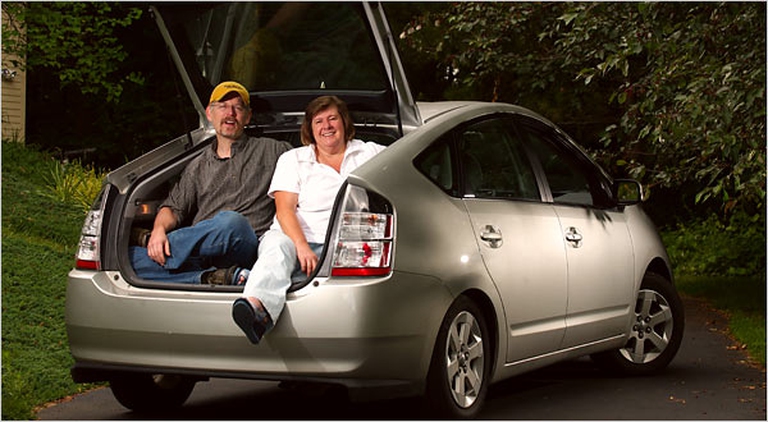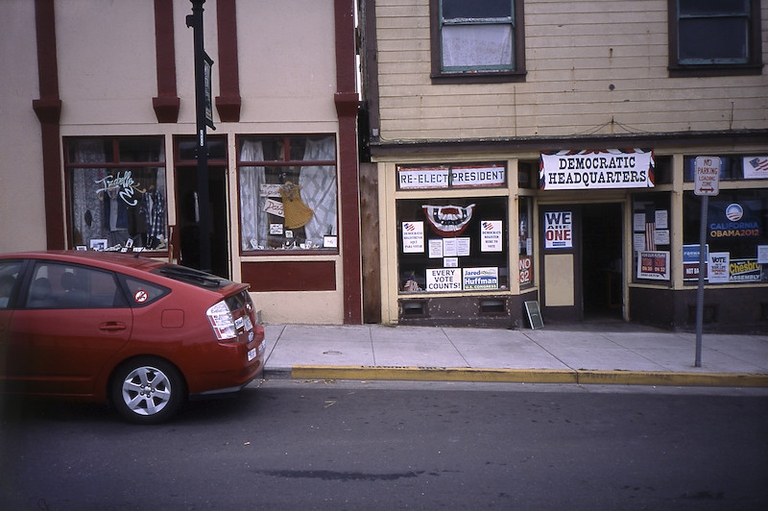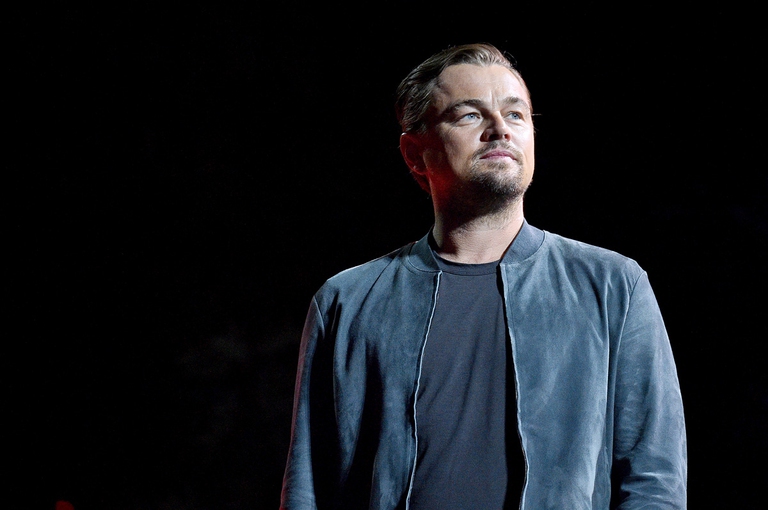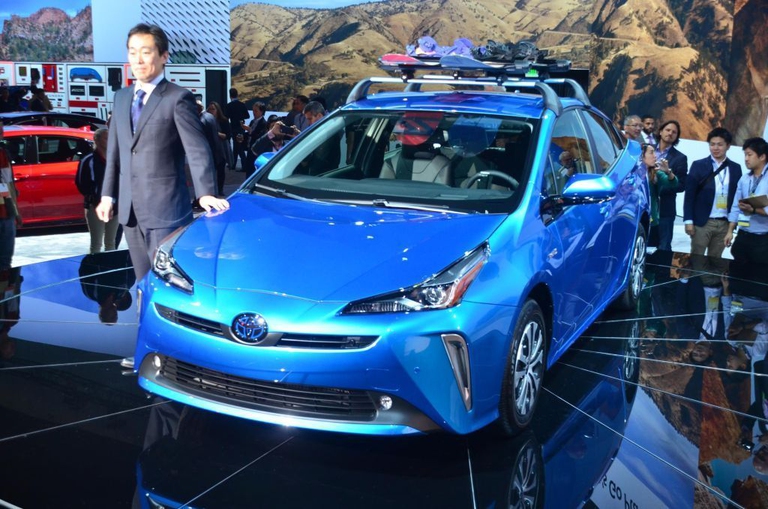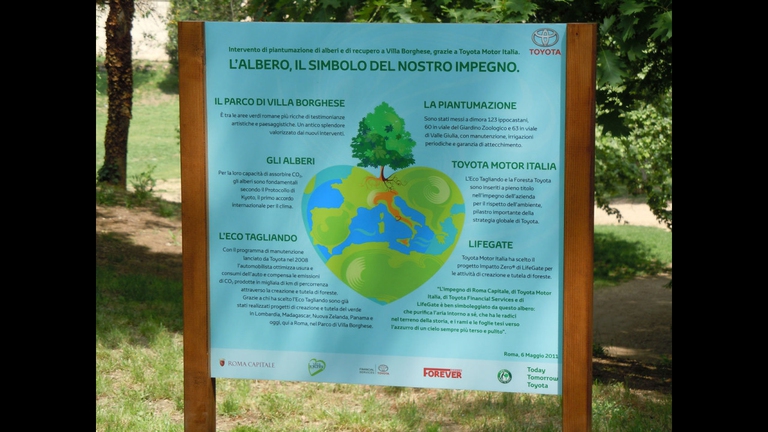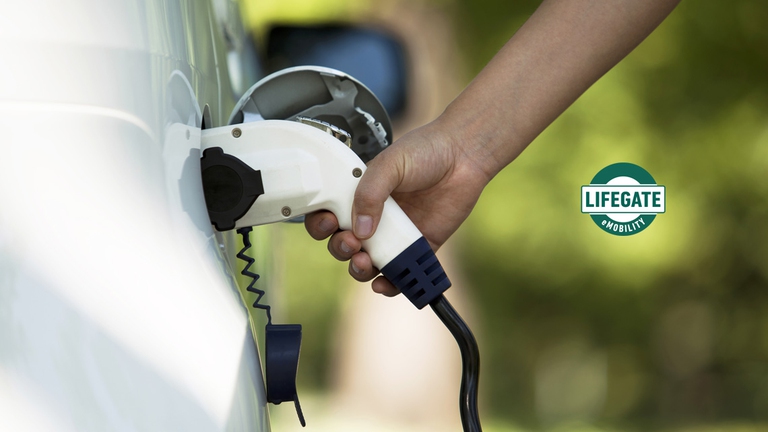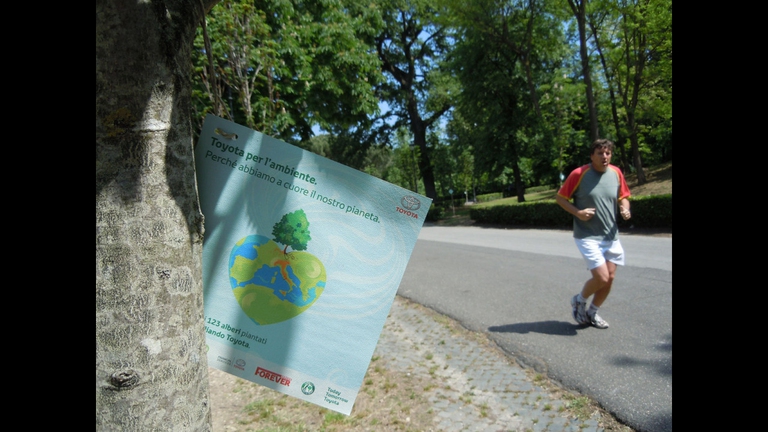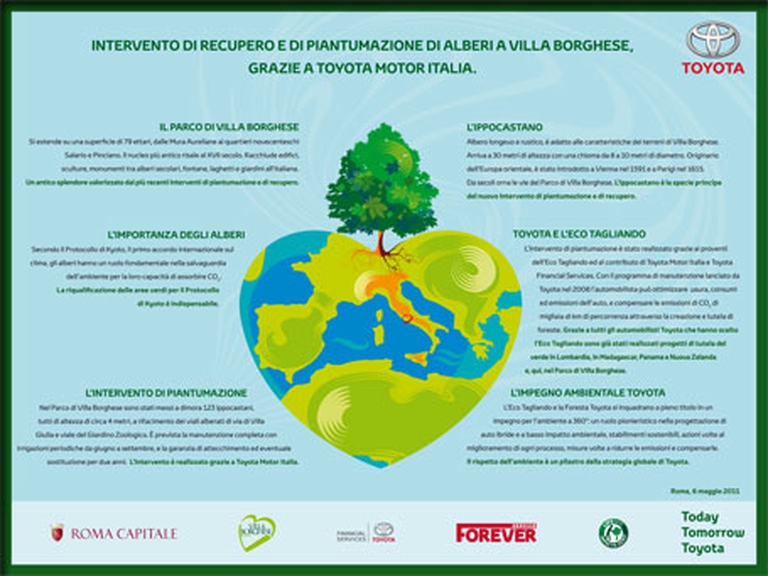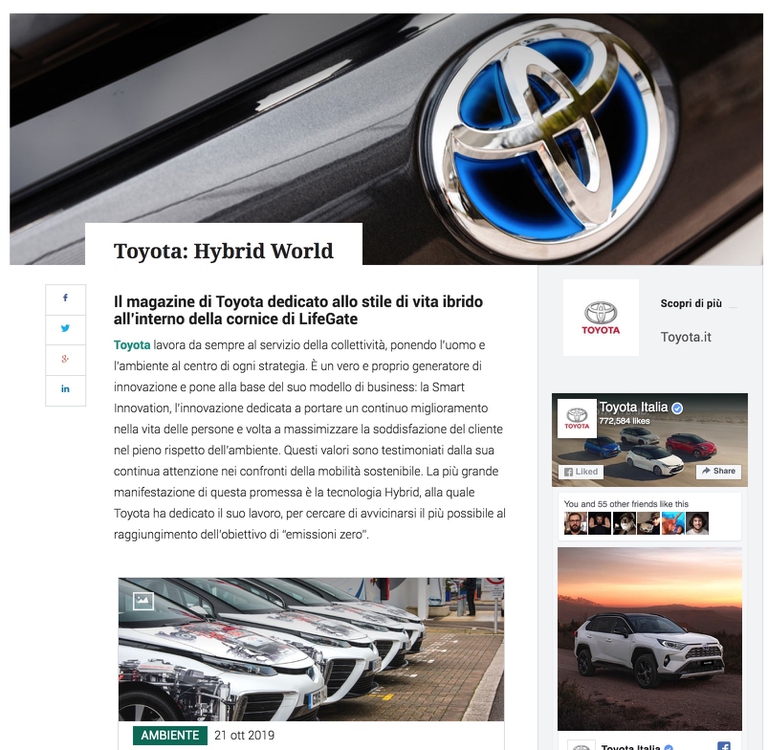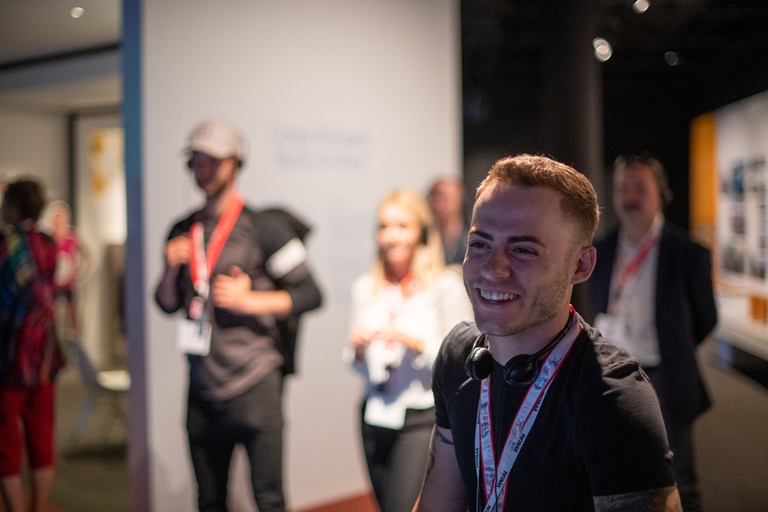
Milan has announced one of Europe’s most ambitious mobility schemes, known as Strade Aperte (open roads). Its goal is to reduce cars in phase 2 of the lockdown by increasing bike lanes and pedestrian areas.
Toyota and LifeGate began telling the story of hybrid mobility back in 2006, now, on the road to the Tokyo 2020 Olympics, they’re still treading the path of sustainable mobility. Here are the main steps of the journey.
The first ecological car servicing, the Ecotagliando, tree planting in Villa Borghese, the publication of Hybrid World magazine, packed with stories and itineraries. Plus, all the successful attempts at illustrating a different, more virtuous approach to mobility. The story – one of a kind in Italy – that for over a decade has linked Toyota, the world’s top car manufacturer, with LifeGate, a benchmark for sustainability in Italy, offers a wealth of ideas and inspiration. And just as we’re about to set off again together on a trip towards the 2020 Tokyo Olympics for a new “human-scale mobility”, it’s time to look back at a unique story, made of elective affinities and shared objectives.
Japan, ten years ago. Toyota announces that it has reached a million Prius cars sold worldwide for the first time, leading to 4.5 million tonnes of CO2 emissions avoided compared to “traditional” car models. This is just one stage of a virtuous journey Toyota embarked upon in 1997, with the launch of the first generation of the Prius, the hybrid model that marked the beginning of mobility’s progressive electrification. It was a brave decision at the time, followed through with a coherent approach rarely seen in the automotive world: hybrid as the choice of elective technology. 2003 saw the debut of the second generation of the Prius. The third came along in 2009: larger and more efficient. Stylistically “stranger” than ever. This also marked the beginning of the collaboration with LifeGate, who became Toyota Italia’s partner in positioning the brand in relation to the values of sustainable mobility, as well as in communicating hybrid technology and its evolution especially to consumers with a high level of awareness of environmental issues.
The global financial crisis causes a sharp drop in sales in the early months of 2009 in many European countries. For example, if we go back and read the Statistical Summary drafted at the time by UNRAE, the association of foreign car makers operating in Italy, we find a clear picture of mobility during those years. “The incentives for new purchases gave a strong boost to the registration of cars with low environmental impact. Specifically, LPG recorded an exponential increase of 450%, accounting for 15.7% of the market. Methane-powered vehicles rose by 160% to a market share of around 6%, and hybrid vehicles grew by 127%, although still with a very small market share (0.35%)”. It was still early days for sustainable mobility in Italy.
Strange. “Clumsy”. For many, “debatable”. In the Nineties, the Prius undoubtedly stands out from the crowd in terms of style. This makes it easily recognisable. While other hybrids at the time, especially those by Honda, are very similar to “normal” cars, Toyota’s model is deliberately different. It’s proud to be different, in fact. This aspect emerges, for example, in an article by US newspaper The New York Times published in July 2007, which analyses the phenomenon in the country: “Buyers of the Prius want everyone to know they’re driving a hybrid”. In Italy, this (still) isn’t the case. But, following an initial collaboration in 2006, LifeGate has already been partnering with Toyota to support its positioning with regards to the values of sustainable mobility for a year.
In order to understand how the Prius “phenomenon” began, we have to go back to the US in 2007. Forbes magazine publishes a study that identifies hybrid car owners as people who are wealthy (with an income of over 100,000 dollars a year), vote the Democratic Party, have a degree, are keen to experiment new technologies – such as MP3 players and digital cameras (the equivalent of today’s smartphones) – and are aged over 50.
It had never happened before, at least not in the recent history of the car industry. A particular model or technology had never won over so many opinion leaders all at once: from Google founders Sergey Brin and Larry Page, to Prince Charles, as well as actor Leonardo DiCaprio, Microsoft founder Bill Gates, Simpsons’ creator Matt Groening and musician Billy Joel, without forgetting actor Tom Hanks and Elon Musk, who at the time had just founded Paypal. They would soon be followed by others: Gwyneth Paltrow and Brad Pitt, Julia Roberts, CNN founder Ted Turner, Sting. This made the Prius – and hybrid vehicles in general – a status symbol in the US, a sort of symbol of a more sustainable, virtuous lifestyle.
Numerous steps forward have been made since then, but the brand’s coherence remains set in stone, and for Toyota, “hybrid” has almost become like a second trademark. In 2012, the Prius family grows to three models, with the addition of two new versions: Prius+ and Prius Plug-in. In 2019, 21 years from its debut, the latest chapter unfolds on the stage of the Auto Show in Los Angeles: the Prius becomes the first Toyota model to be equipped with the new smart electronic all-wheel drive Hybrid AWD-i system.
This was what was happening in the rest of the world, especially in the US. What about Italy? In the first decade of the new millennium, the Italian car market shows little interest in hybrid vehicles. Awareness of environmental issues is much lower than it is today, and above all, when it comes to choosing a car, little thought is given to emissions and often not even to efficiency. It is in this context that Toyota chooses LifeGate to embark on a journey towards sustainable mobility, which continues to this day, and has brought on board numerous positive changes. This collaboration is founded on an important premise. Starting from the fact that the digital optimisation of LifeGate’s content for Toyota is based on two effective means of communication: journalistic content and content that can be accessed by the community in the section dedicated to Toyota; this same content is then posted, relaunched and disseminated via LifeGate’s social media platforms: Facebook, Twitter, LinkedIn and Instagram. The LifeGate community shows great interest from the very start, and the project has moved full steam ahead.
What is required above all are actions capable of stimulating awareness, basically non-existent at the time. This leads Toyota and LifeGate to find a common denominator: sustainability. This is the starting point of a series of initiatives that remain active to this day. This shared mission to help the environment underpins a new project: the Ecotagliando ecological car servicing, designed to reduce consumption and environmental impact. This becomes the first step in moving traditional car servicing towards a greener, high-tech version. Using more advanced technologies and spare parts, Toyota Motor Italia guarantees its customers lower costs and a reduced environmental impact. And thanks to LifeGate’s Zero Impact® programme, drivers can help protect the environment by contributing to the planting and safeguarding of growing forests in Italy and worldwide. In fact, for every Ecotagliando car servicing, Toyota participates in LifeGate’s project to offset CO2 emissions. The launch of this service marks the beginning of a veritable revolution in communicating hybrid technology in Italy.
Toyota and LifeGate. Over the years, the two have developed profoundly shared values when it comes to mobility. For Toyota, this period is characterised by a growing belief that sustainable mobility means guaranteeing freedom of movement, without forgetting respect for the environment. This progressive concept is fully in line with the values of Mobility Revolution, LifeGate’s project that seeks to support people and companies with projects, services and tools to provide information and help them make decisions around mobility, with the aim of reducing the environmental and social impact of transport. LifeGate has developed a sustainability assessment index for cars which Toyota adopts in Italy to promote the advantages of its hybrid range in the realms of marketing and communication. For the first time, the criteria to analyse cars are extended to their environmental impact, cost efficiency, technological innovation and smooth, trouble-free driveability. This assessment remains the only one of its kind to date.
Another significant step forward on the LifeGate-Toyota journey. May 2011 sees the beginning of the redevelopment of certain parts of the Villa Borghese Gardens, one of the green areas richest in art and landscape features in Rome. Celebrated with the symbolic planting of a tree, the event is attended not only by institutional representatives and Marco Roveda, founder and president of LifeGate, but also by then CEO of Toyota Motor Italia, Motonobu Takemoto. The project will ultimately see the planting of 123 horse-chestnut trees.
Research carried out by LifeGate on a sample of 1000 consumers, selected for their high level of awareness, shows that more than half of those interviewed are prepared to choose more sustainable means of transport to help reduce pollution and improve quality of life in urban areas. Mobility Revolution, in fact, offers an entire editorial section dedicated to sustainable mobility. The project seeks to act as a point of reference and space for dialogue for those who aspire to a healthier, more liveable environment; cars more in line with their personal needs and aspirations; and technologies that improve quality of life. The focus of this storytelling and the concrete actions undertaken increasingly shifts from cars to people.
To this end, the Mobility Revolution project sees the drafting of a ten-point manifesto, to be read and shared, designed to foster dialogue on issues such as life in urban areas, choosing the right means of transport, safety and peace of mind, saving money, innovation and hybrid technology. The manifesto offers a new avenue for users to make choices, in view of a shift away from basing these on performance and superfluous accessories, and instead towards the values, innovation and technology embodied in a car. In addition, by continuously updating information via its platforms, LifeGate keeps readers informed about the latest news and most sustainable behaviours to adopt with regards to mobility.
In addition to communicating with people, LifeGate and Toyota are also engaged in a dialogue with the world of business. In particular, because company fleets significantly impact the number of vehicles in circulation, and therefore the environment. The fleet configurator is a tool conceived for company vehicle fleets that compares “traditional” car fleets with those composed of hybrid vehicles in terms of sustainability, making it possible to highlight the benefits offered by more advanced technologies.
The journey shared by LifeGate and Toyota has never stopped exploring new avenues. Such as the launch of Toyota’s first lifestyle magazine created within the LifeGate framework. Toyota thus gives increasing importance to placing humans and the environment at the centre of all its strategies, with the aim of fostering innovation that can improve people’s lives while respecting the environment. Through issues that touch upon all aspects of people’s lives and following in the footsteps set out by Toyota, Hybrid World explains the important shift towards a “zero emissions” future, a concept that today, some years later, Toyota has reinforced thanks to the launch the Mirai model, whose name means “future” in Japanese, which adopts hydrogen technology as the motor to power an increasingly virtuous form of mobility.
With the aim of supporting the sustainable positioning of the Japanese brand, LifeGate has turned the magazine into a project: Hybrid Lifestyle, designed to inform the wider public about the advantages of hybrid technology as a founding element of sustainable mobility. The focus has definitively moved to the advantages for users in terms of lifestyle, respect for the environment and money saving, as well as satisfaction and pride. For LifeGate, the test drives of the Toyota hybrid range offer a new approach to communication, linked to wider themes and first-hand accounts.
:
This is how LifeGate proposes to intercept potential buyers, by mapping their interests. Toyota has accepted this proposal, and the shared journey they’ve embarked on – the only one in Italy between a communication network and a car manufacturer – has taken off again on a new footing. The structure of the project includes the development, on the part of LifeGate’s editorial staff, of content on current affairs and “hybrid lifestyle”, disseminated via online and offline communication channels. The new themes? Start your Impossible, #Tokyo2020, electrification and mobility for people. For the first time, a detailed feature is also added on a previously unexplored topic, though certainly important: pollution from nitrogen oxides, harmful gases and the emissions that cause global warming. LifeGate and Toyota thus once again step in a new dimension, with the scope of moving storytelling further in the direction of lifestyle.
Lausanne, Switzerland, 10 years later. This time, LifeGate is chosen by Toyota as the only Italian participant in a group of international influencers for a project that looks to the Olympic Games in Japan. Toyota recognises that over twenty years, LifeGate has brought a unique approach, skills and language to explaining mobility’s evolution, and at the same time, underlines its own ground-breaking transformation from a “simple” constructor into a mobility company capable of offering people new and innovative “resources” to get around, travel or simply overcome everyday obstacles. LifeGate once again shares this approach, and with the Start your Impossible project, embarks on a new stage of the journey. The Toyota Team, a group of athletes from a variety of Olympic and Paralympic disciplines, will be carrying the Italian tricolour flag at the Tokyo Olympic and Paralympic Games, and their adventures will be told right here in these pages. Technology, innovation, artificial intelligence and robotics are the new issues to be looked into in detail. Themes that LifeGate will play a key role in, covering them live from the Tokyo Motor Show. To continue on the journey towards the summer Olympics. This, however, is a whole new chapter waiting to be written.
Siamo anche su WhatsApp. Segui il canale ufficiale LifeGate per restare aggiornata, aggiornato sulle ultime notizie e sulle nostre attività.
![]()
Quest'opera è distribuita con Licenza Creative Commons Attribuzione - Non commerciale - Non opere derivate 4.0 Internazionale.
Milan has announced one of Europe’s most ambitious mobility schemes, known as Strade Aperte (open roads). Its goal is to reduce cars in phase 2 of the lockdown by increasing bike lanes and pedestrian areas.
Formula 1, the world’s most important auto racing championship, has decided to turn the page and aim for carbon neutrality with the support of its teams, drivers and the whole racing circus.
Germany’s first solar bicycle lane could be the prototype for the roads of the future. The photovoltaic tiles melt snow and ice, and are capable of absorbing noise.
The Vespa is back in an electric version. Production has just started and the first models can be reserved online starting from October.
The city of Utrecht, in the Netherlands, is home to a bridge for cycling and walking that stretches over roof garden of a Montessori school. This project enhances practicality and will allow families to bring children to school by bike, passing through green areas. Despite their functionality, bridges are often seen as an infrastructure that is
The Lego hair bike helmet is the latest Internet craze. For now it’s just a prototype but production on a large scale will probably start soon.
Just as fires often give way to new growth, after the Dieselgate scandal, which saw Volkswagen cheating on US emission rules, the German car manufacturer radically changed course, beginning to focus on sustainable mobility. The German car company aims to propose thirty zero-emission models and produce at least one million battery electric vehicles by 2025. An ambitious mission
Sustainable, two-wheel mobility is triumphing in Copenhagen. After years of investments, policies, and infrastructural changes, bikes now outnumber cars in the city centre. The website Copenhagenize has released data linked to the number of vehicles entering the city centre, which are monitored by the city’s administration on a daily basis. Last year, 265,700 bikes have entered
A luminous cycling strip has recently been unveiled in Poland: created in the town of Lidzbark Warminski, the cycling lane glows blue at night, a feast for the eyes. Features of the bike path The lane is divided into two sections – one for cyclists, one for pedestrians – so that everybody can enjoy such
